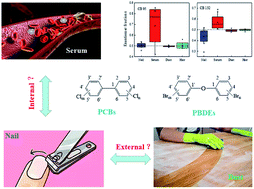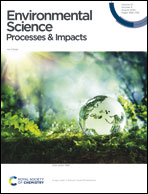Levels and sources of PBDEs and PCBs in human nails from e-waste, urban, and rural areas in South China†
Abstract
Human nails have been increasingly used as a biomarker for human exposure to persistent organic pollutants (POPs). In the present study, the fingernails of e-waste-dismantling workers from Longtang town, Qingyuan city, rural residents from Shijiao town, Qingyuan city, and urban residents from Guangzhou city, respectively, were collected from South China to monitor the human burdens of polybrominated diphenyl ether (PBDEs) and polychlorinated biphenyl (PCBs). The median concentrations of  in the nails of the e-waste-dismantling workers, and urban and rural residents were 412, 129, and 82.1 ng g−1, respectively, and the median concentrations of
in the nails of the e-waste-dismantling workers, and urban and rural residents were 412, 129, and 82.1 ng g−1, respectively, and the median concentrations of  were 108, 8.4, and 22.1 ng g−1, respectively. The levels of PCBs and PBDEs in the nails of e-waste-dismantling workers were significantly higher as compared to those for urban and rural residents (p < 0.05), implying the continuous and greater exposure to these chemicals in the e-waste recycling areas. BDE 209 (92–98%) was the major congener of PBDEs and CB 52 (26–51%) was the main congener of PCB in nail samples. However, no significant gender difference was observed for PBDE and PCB levels in nails from all three investigated areas, and no significant correlation was found between their levels and the age of the participants. The enantiomer fractions (EFs) of CBs 95 and 132 indicated that the external sources (e.g. dust and/or air) were the primary sources for CBs 95 and 132 in human nails from the e-waste area, while the contribution from the internal sources (e.g. serum) could be in a small percentage. The results of this study indicate that human nails can be used as a proper indicator of human exposure to PCBs and PBDEs, and further studies are needed by a comprehensive investigation of the relationships between the PCB and PBDE levels in the nails and serum and/or other internal tissues.
were 108, 8.4, and 22.1 ng g−1, respectively. The levels of PCBs and PBDEs in the nails of e-waste-dismantling workers were significantly higher as compared to those for urban and rural residents (p < 0.05), implying the continuous and greater exposure to these chemicals in the e-waste recycling areas. BDE 209 (92–98%) was the major congener of PBDEs and CB 52 (26–51%) was the main congener of PCB in nail samples. However, no significant gender difference was observed for PBDE and PCB levels in nails from all three investigated areas, and no significant correlation was found between their levels and the age of the participants. The enantiomer fractions (EFs) of CBs 95 and 132 indicated that the external sources (e.g. dust and/or air) were the primary sources for CBs 95 and 132 in human nails from the e-waste area, while the contribution from the internal sources (e.g. serum) could be in a small percentage. The results of this study indicate that human nails can be used as a proper indicator of human exposure to PCBs and PBDEs, and further studies are needed by a comprehensive investigation of the relationships between the PCB and PBDE levels in the nails and serum and/or other internal tissues.

- This article is part of the themed collection: Environmental exposure and impacts


 Please wait while we load your content...
Please wait while we load your content...